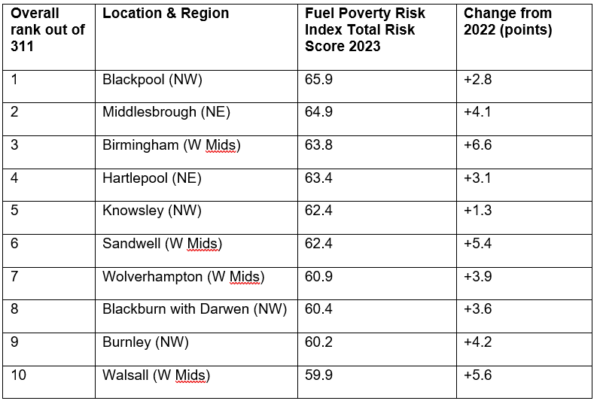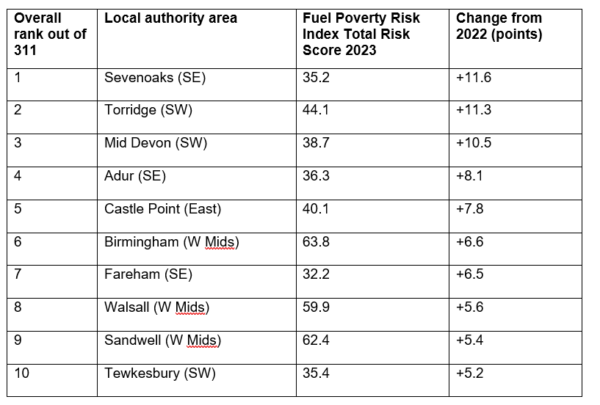Nov
2023
Southern England feels the cold as fuel poverty bites
DIY Investor
7 November 2023
New data from the Open Data Institute shows the North-South divide in fuel poverty narrows as more people in Southern England experience fuel poverty
The first annual update to the Open Data Institute’s (ODI) Fuel Poverty Risk Index, published today, demonstrates the value of data infrastructure to help understand the scale and depth of fuel poverty across England.
The Index combines more data than any other available for England. It scores each area across multiple indicators, including climate, income, deprivation, benefit receipt, and housing stock, to show the areas of highest need. The data analysis reveals a surprising picture of England.
Wide geographic variations in fuel poverty continue across England. The ODI has identified the top ten local authorities for fuel poverty risk – the highest rises year-on-year are in the South East and South West of England. Fuel poverty increases in the South East may surprise many as the annual income measure used by the ODI’s index shows high average incomes in the area.
The data in the ODI’s index demonstrates that fuel poverty across the UK has got worse in the last year, with the average fuel poverty risk index score across England increasing from 39.0 in 2022 to 41.2 in 2023. The top ten local authorities with the highest risk of fuel poverty have the worst index score year-on-year when comparing the ODI’s 2022 and 2023 fuel poverty risk indexes.
Just 15% of the 290 Local Authority Districts (LADs) analysed saw a year-on-year decrease in their fuel poverty risk.
More than 3.6 million people are missing from the official data and potentially in fuel poverty due to the way fuel poverty is defined as only homes with an EPC rating of D or below, even if occupants of homes with a higher EPC rating are struggling to pay energy bills.
Government fuel poverty statistics continue to reflect wide geographic variations: the West Midlands and Yorkshire and the Humber have the highest proportion of households in fuel poverty (19% and 16% respectively) in England and higher than London at 13%.
Based on the ODI’s fuel poverty risk index, for the second year running, households living in Blackpool have the highest propensity for fuel poverty.
The ODI’s Fuel Poverty Risk Index is a unique look at fuel poverty, drawing on 12 distinct datasets – and four supporting datasets – to help understand the scale and depth of fuel poverty across England. It allows users to compare data nationally and at local authority level and is free of charge for anyone to use.
The ODI’s latest data analysis – comparing its 2022 and 2023 fuel poverty risk indexes – updates on the ODI’s Fuel poverty and data infrastructure report and traces the impact of government intervention and payment schemes from 2022-2023, including the end of universal help in April 2023, on different local authorities in England.
The fuel poverty risk index is a data visualisation tool that highlights the impact of fuel poverty and drills down to local authority areas, showing which locations are at the most risk of fuel poverty. The 2023 index also reflects the increase in benefits claimed across England, where the average proportion of residents claiming Universal Credit increased from 13.2% in 2022 to 14.2% in 2023.
Official data is likely to significantly underestimate the number of people in fuel poverty. ODI analysis in September 2023 identified that as many as 3.6 million people are missing from the official data about fuel poverty, due to the way fuel poverty is defined in the Low Income, Low Energy Efficiency (LILEE) indicator. This specifies that only homes with an EPC rating of D or below can be counted, even if their occupants are struggling to pay their energy bills.
Resham Kotecha, Head of Policy at the ODI, said:
“The updated fuel poverty index illustrates the need for an effective national data infrastructure to target help from energy companies, government and charities efficiently. We can identify those most in need of support, see how these needs are evolving and pinpoint which groups might need support. Effective data collection and infrastructure would assist policymakers, charities, and community groups target and direct support so that the most vulnerable in society get the support they need. Regularly updated data analysis would mean that decisions would be based on accurate information and that taxpayer’s money is used effectively.”
“There is a greater need than ever for better data infrastructure to help address our most pressing challenges. The ODI believes that a strong, trustworthy data infrastructure is the lifeblood of the global economy, on a par with essentials like clean water and transport networks.”
Dr Tom Kerridge, Policy and Research Manager, Centrepoint, said:
“Many people will be unsurprised to see areas such as Blackpool continue to suffer fuel poverty, but this new analysis sheds light on the fact that areas such as Torridge in Devon are also suffering. Continued access to high-quality open data on issues such as this will be important for organisations who offer support to people affected by fuel poverty, and ensure that efforts are directed towards those who need it most.”
Simon Francis, Co-ordinator of the End Fuel Poverty Coalition, which is also part of the Warm This Winter campaign, said:
“The data reveals that the energy crisis is far from over and is, in fact, getting worse. The analysis should highlight to the government and support agencies that further targeted support is urgently required during the coming cold winter months. The Index suggests a strong case for delivering long-term system reforms and improvements to the energy efficiency of buildings.”
The Fuel Poverty Risk Index is the ODI’s latest deep dive into the national data infrastructure around social challenges. In September 2023, the ODI published data analysis on ‘The cost of living: how data can help tackle the crisis’. Both pieces of analysis reveal gaps and inconsistencies in the data and disparities in how data is captured by different organisations. A national standard in data collection and better national data infrastructure would allow the government, local authorities, charities and other front-line services to cost effectively target help to those who need it most.
The ODI Fuel Poverty Risk Index local authority data
The ODI calls for the publication of fuel poverty data in full, removing the omission of English homes with an EPC rating of C or above in fuel poverty statistics. In Scotland, Wales and Northern Ireland those in poverty in such homes are included in the statistics. 52.8% of all low-income households in England lived in a property with an EPC of C or above, but all of those were excluded from fuel poverty statistics. This equates to approximately 3.6 million households and paints an inaccurate picture of fuel poverty in England and the UK as a whole.
1. The top ten regions for fuel poverty:

2. The top ten regions showing the greatest increases in fuel poverty:

What do we mean by fuel poverty?
A household is described as being in fuel poverty when the occupants are unable to afford to heat (or cool) their home to an adequate temperature. There are three primary drivers of fuel poverty:
· Low income
· Unit costs of fuel.
· Energy efficiency of the property
About the Open Data Institute The ODI is a non-profit with a mission to work with companies and governments to build an open, trustworthy data ecosystem where people can make better decisions using data and manage any harmful impacts. We work with a range of organisations, governments, public bodies and civil society to create a world where data works for everyone. Our work includes applied research, consultancy services, training, and providing free reports, tools and webinars. We focus our efforts on three broad areas:
· Improving the data practices of organisations so that they can build and manage adequate data infrastructure and data use.
· Tackling challenges so that the data ecosystem works better.
· Gathering and creating research, evidence and knowledge about data and benefits of open, trustworthy data access.
The ODI was co-founded in 2012 by the inventor of the web, Sir Tim Berners-Lee and artificial intelligence expert Sir Nigel Shadbolt to show the value of data and to advocate for its innovative use to affect positive change across the globe. We’re an independent, non-profit, non-partisan company headquartered in London with an international reach.
Molly’s story
At the age of 18, my finances became very challenging when circumstances led me to become independent and estranged from my family, which thrust the responsibility of financial stability squarely onto my shoulders. Juggling full-time studies with a deepening mental health crisis was an immense challenge. The weight of financial burdens felt even more overwhelming.
The winter of 2022 brought a new level of hardship. Existing mental health struggles and personal barriers were exacerbated by the escalating cost of living crisis, sending my anxiety levels skyrocketing. I found myself compulsively checking my bank account, fearing the toll it would take on my already stretched budget. Truthfully, the winter of 2022 stands out as one of the hardest periods of my life due to these circumstances.
In our student household, we went to great lengths to save money, even enduring days without heating and dealing with frozen pipes that frequently led to cold showers. Looking back, I realise I prioritised finances over my own health. It’s clear to me now that no young person or household should ever have to face such a choice. It’s a basic right for every young person to feel warm and comfortable in their own home.
I’ve now completed my course and am working full time in my first job. It’s a relief to be earning, but money is still very tight, and this winter, I will still have to keep the amount of time the heating is on to the absolute minimum to keep the bills low.
Leave a Reply
You must be logged in to post a comment.